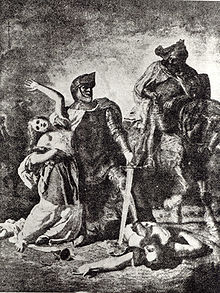Arnold from Vitinghove
Arnold von Vitinghove ( Vietinghoff; † July 11, 1364 ) was Landmeister of the Teutonic Order in Livonia from 1360 to 1364 . He came from the Westphalian noble family of the Vietinghoffs in the county of Mark with the Vittinghoff parent company (now in ruins) near Essen-Rellinghausen .
Arnold of Vitinghove distinguished himself as Gebietiger and Landmeister repeated the Teutonic Order in the Litauerkriegen of the Teutonic Order from.
Life
In the years 1341 to 1346, von Vitinghove was first mentioned in a document as Commander of the Teutonic Order of Marienburg in Livonia. In 1348 he became Commander of Reval . In 1360, the “Landkapitel” of the Livonian branch of the Order awarded him the dignity of Landmeister , which was confirmed by Grand Master Winrich von Kniprode .

In the same year he undertook a first successful campaign against the Shamaite boyar Eginthen, who, according to the chronicler, boasted that he wanted to drive all Christians and Germans out of the country. A year later, a so-called "war Journey", on the Vitinghove of the followers of the Lithuanian nobles zywa captured and so zywa itself a vassal made the Order.
In 1362 Arnold undertook further military expeditions to Shamaiten. In military coordination of the Livonian branch of the order with Prussian knights under Grand Master Winrich von Kniprode, the Lithuanian castle Kaunas was to be destroyed. The Grand Master and Arnold von Vitinghove's forces besieged the heavily fortified castle from March 1362. The strategically important fortress was captured in mid-April. With the capture of Kaunas the capture of a son of the Lithuanian Grand Duke Kęstutis succeeded . At this time he was, along with his brother, the Grand Duke Algirdas , the most dangerous opponent of the Teutonic Order's expansive plans in Shamaites. Another extensive campaign of the Livonian branch of the order against Shamaites was led by Vitinghove in the autumn of the same year.
On June 10, 1362, a meeting of the landmaster with the Livonian bishops of Ösel , Reval and Dorpat, the abbots of Kalkena and Padeş , “the provosts and canons of Riga, as well as knights, squires and citizens of the whole country took place in Dorpat . “The meeting dealt with grievances and rivalries in the state administration. The master complained that “Mr. Johannes, Bishop of Dorpat, denigrated him and the order with kings and princes, as well as with the seaside towns, that he did not support him and the order in the fight against the Lithuanians, and also with subjects of the order The bishop, for his part, certified his loyal behavior towards the order, but this did not prevent him from filing another lawsuit before Pope Urban V against the Landmeister Arnold and the Teutonic Order as a whole.
In 1363 Arnold undertook a new campaign to the "Land of the Opithen" (on the bank of the river "Nawese"), where his army "badly devastated the country."
In 1364 Grand Master Winrich von Kniprode and Landmeister Arnold met as part of another “Lithuanian procession” near Wilkomir Castle , “where they remained for nine days under devastation and the removal of many prisoners.” Ordensheeres destroyed the food for the Ordensheeres and, above all, the logistically important horse feed.
On July 11, 1364, the landmaster Arnold von Vitinghove died under unexplained circumstances. His successor as Landmeister of Livonia was Wilhelm von Friemersheim .
literature
Contemporary chronicles
- Hermann von Wartenberg : Chronicon Livoniae. (around 1378)
Source editions
- Theodor Hirsch, Max Toeppen, Ernst Strehlke: Scriptores rerum Prussicarum. The historical sources of the Prussian prehistoric times up to the fall of the order . Volumes 1–5, Leipzig 1861–1874.
- Zenonas Ivinskis: Lietuvos istorija Iki Vytauto Didžiojo mirties ; [Lithuanian history up to the death of Vytautas the great], Vilnius 1991.
- Rimas Varanauskas: Lietuvos ir Livonijos santykiai XIII– XVI a. ; [Lithuanian-Livonian Relations in the 13th to 16th Centuries], Vilnius 1982.
Individual evidence
- ^ Theodor Hirsch, Max Toeppen, Ernst Strehlke: Scriptores rerum Prussicarum . The historical sources of the Prussian prehistoric times up to the fall of the order . Volume 2, page 244 ff.
- ↑ a b c d e f g h Hermann von Wartenberg: Chronicon Livoniae.
- ^ Theodor Hirsch, Max Toeppen, Ernst Strehlke: Scriptores rerum Prussicarum. The historical sources of the Prussian prehistoric times up to the fall of the order . Volume 2, page 245.
- ↑ Zenonas Ivinskis: Lietuvos istorija Iki Vytauto Didžiojo mirties ; [Lithuanian History up to the Death of Vytautas the Great], p. 67.
Footnotes
- ↑ Arnold's Landmeister coat of arms was also characterized by the three shells, underlaid with a black bar on a white background, under the stech helmet.
- ↑ A tributary of the Memel that cannot be clearly located today , according to Strehlke: Scriptores rerum Prussicarum. The historical sources of the Prussian prehistoric times up to the fall of the order. Volume 2, page 242, presumably the Nevėžis .
| predecessor | Office | successor |
|---|---|---|
| Goswin from Herike |
Landmaster in Livonia of the Teutonic Order 1360–1364 |
Wilhelm of Friemersheim |
| personal data | |
|---|---|
| SURNAME | Vitinghove, Arnold von |
| ALTERNATIVE NAMES | Vietinghoff, Arnold von |
| BRIEF DESCRIPTION | Commander of the Teutonic Order |
| DATE OF BIRTH | before 1341 |
| DATE OF DEATH | July 11, 1364 |
